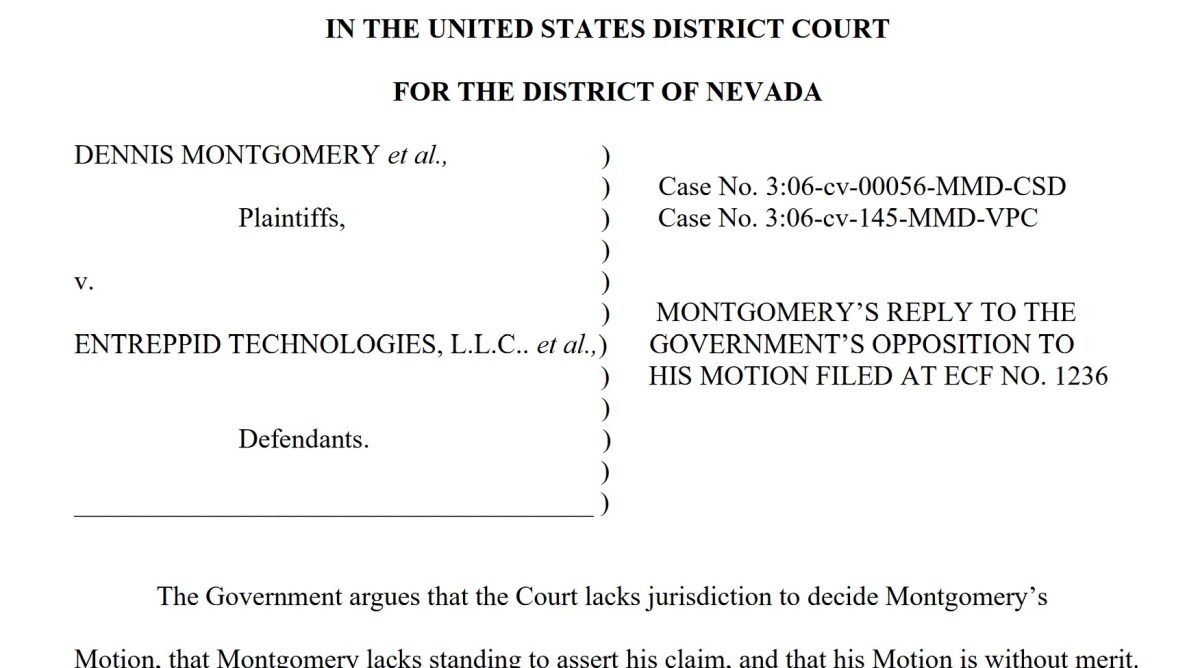by Sharon Rondeau

(Dec. 26, 2022) — On December 20, attorneys for former government subcontractor Dennis Montgomery filed a response contradicting the U.S. Justice Department’s December 5 brief contending Montgomery did not have the requisite “standing” to request the lifting of a 15-year-old protective order invoked in 2006 litigation between Montgomery and his former business partner, Warren Trepp.
Montgomery’s lawsuit against eTreppid, the company he and Trepp founded in 1998, and Trepp’s countersuit over copyright claims to software and source code were consolidated and resolved in 2008 through the U.S. District Court for the District of Nevada, where new filings were made beginning with MyPillow CEO Mike Lindell and Montgomery on August 20, 2022.
The protective order, granted in August 2007 by Judge Philip M. Pro, imposes non-disclosure over eTreppid’s contractual work with the Defense Department in the early 2000s. Believing the protective order also applies to alleged “election”-related technology and evidence Montgomery reportedly gleaned from the 2020 election and sold to Lindell last year, Lindell has asked the presiding judge to issue orders clarifying he is free to release Montgomery’s information to the public so that he might invoke it in a defense against a lawsuit from Dominion Voting Systems, Inc.
In an October filing, the Justice Department, responding on behalf of the U.S. government, wrote that Lindell is not restricted in any way by the protective order.
On his website and in claims made to others, Montgomery states he possesses massive evidence of illegal surveillance by the U.S. government on its own citizens and has submitted dozens of “whistleblower” reports which have been ignored. “I followed the proper state protocols for whistle-blowing and raising issues, only to be ignored, arrested by force, prosecuted, persecuted, discredited, slandered, defamed, and libeled,” Montgomery claims on the website. “I could have sold the data and made millions of dollars, but didn’t. I could have sold secrets from every defense contractor in this country, but didn’t, I could have dumped 600 million pages of sensitive information on Americans and their businesses on the internet and fled to Russia, but didn’t.”
On October 31, 2020, Montgomery’s claim to not only having “built” a super-computer system, “The Hammer,” and software, “Scorecard,” for the government, but also that the government deployed the technology to change the outcome of the presidential election, was published at The American Report by Mary Fanning and Alan Jones and widely circulated. The article further claimed, without presenting any evidence, that when he was vice president under Barack Obama, Joe Biden used the same system to commandeer the 2012 presidential/vice-president contest in their favor.
Montgomery’s newest filing in the reopened eTreppid case begins with, “The Government argues that the Court lacks jurisdiction to decide Montgomery’s Motion, that Montgomery lacks standing to assert his claim, and that his Motion is without merit. None of these arguments are viable.”
In a previous filing, Montgomery’s attorneys requested the court to “Restrict Application of the State Secrets Privilege Pursuant to 50 U.S.C. § 403-1(i)(1),1 the Protective Order Entered on August 29, 2007, and the Classified Information Nondisclosure Agreement Executed by Montgomery,” which Montgomery signed when he was a co-owner of eTreppid and involved in the company’s government contracts.
Their justification for the lifting of the order would allow Montgomery to “defend against claims asserted by the Internal Revenue Service, and permit him to use his intellectual property,” the attorneys asserted, as well as to respond to a subpoena he received from Lindell associated with the Dominion case.
In its responses to Montgomery’s latest motions, the Justice Department argued to maintain the protective order and contended that it pertains to nothing associated with election technology, voting or the 2020 election specifically.
In his latest filing, Montgomery argued that “The Lindell subpoena triggered Montgomery’s filing of the Motion because it confronted him with an unavoidable choice, but it is relief from the restrictions of the Protective Order and not the subpoena itself that prompted Montgomery’s Motion. Until he was served with the subpoena, Montgomery had declined to confront the Government’s abusive resort to an inappropriate reading of the Protective Order because of its threats of arrest and prosecution and the prospect of another illegal raid, such as occurred in 2006 at his Reno residence.”
The “illegal raid” refers to the FBI’s search of Montgomery’s residence and storage units which then-Magistrate Judge Valerie P. Cooke later ruled violated Montgomery’s Fourth Amendment rights. Last year Montgomery sued the lead agent, Michael West, over the raid via the “Bivens action” referenced in Montgomery’s last brief.
After the consolidated Montgomery and eTreppid cases proceeded and came to a close, Cooke referred Montgomery to the Justice Department on a finding of perjury which was ultimately not prosecuted.
“The court should enter an Order declaring the plain meaning of the Protective
Order to be that it applies only to discovery or disclosure in this terminated litigation and not to any other litigation or situation,” Montgomery’s attorneys concluded their brief.

